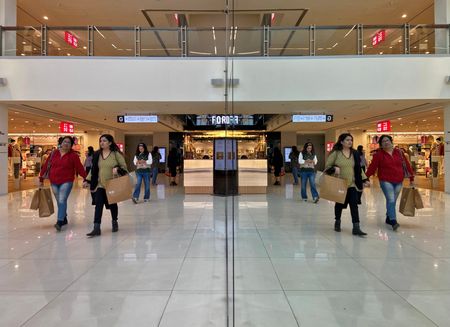By Ira Dugal
MUMBAI (Reuters) – India is set to be the world’s fastest growing major economy in the year ahead, as a post-pandemic retail boom and recent bank balance-sheet repairs lure new investment, fueling hot demand for everything from cars to televisions, coal and airliners.
The world’s fifth-largest economy is expected grow 6% in the fiscal year ending March 31, 2024, according to a survey by the Indian central bank this month.
While slower than the current fiscal year’s projected 6.8% growth, the outlook contrasts with bleaker 2023 projections in the United States, Europe and most noticeably China, a major Asian economic rival where a recent surge in COVID infections is expected to hobble activity next year.
Importantly, conditions are better than not just the crippling slump during India’s devastating COVID surge last year but also the anemic growth of the debt-saddled last decade.
The more upbeat mood is shoring up spending and investment in India, although the recovery is expected to be an uneven one, benefiting the urban and domestic sectors more than struggling rural and export-oriented parts of the economy.
“If India does everything right, we could see significant foreign inflows in the next one to two years,” said Sridhar Sivaram, investment director at Enam Holdings, a privately managed investment group.
He is most bullish on Indian banks, which are having a “Cinderella moment” – a phrase popularised by billionaire-banker Uday Kotak, because of high credit demand and reduced defaults.
India’s weight in the MSCI emerging market index has already risen from 8% in 2019 to 16% as of October 2022, said Sivaram.
Foreign portfolio investors sold a net of $18 billion this year but turned buyers in November and December, with financial stocks accounting for a third of the inflows last month.
Longer term foreign direct investors have put in $22 billion into India between April-October 2022, on par with the previous year. Computer software, services firms, trading, non-conventional energy and chemicals made up more than half the inflows until September this year, government data shows.
UNEVEN REBOUND
Economic activity picked up after a third wave of COVID infections in 2021, which was less severe than feared and led to most COVID restrictions being lifted, releasing pent-up demand for homes to cars and consumer goods in urban areas.
Pradeep Bakshi, chief executive of consumer appliances company Voltas, said sales have been driven by a backlog of orders and easier financing options, such as buy-now-pay-later schemes, which reduce upfront payments for consumers.
Demand for services such as hospitality, travel and leisure, rose 7.4% in the September quarter from the same period in 2019, before the COVID crisis hit, gross domestic product data showed.
“We are back in expansion mode with a vengeance, after a period when we didn’t know whether we would survive,” said Anjan Chatterjee, managing director at Specialty Restaurants, which runs eateries across the country.
Overall, September quarter private consumption rose 7.8% from pre-COVID levels in 2019 while a sharp increase in government spending has pushed up fixed capital formation, an indication of investment activity, 13.5% from 2019, GDP data showed.
INVESTMENT RECOVERY
India’s re-opening is one reason power and coal demand is strong, pushing the government to step up gas imports, while more companies are seeking bank credit as they add capacity.
Air India, for example, is looking at landmark orders for as many as 500 jetliners worth tens of billions of dollars from both Airbus and Boeing, Reuters reported this month.
Not all indicators are signalling the same level of economic strength, however.
Unemployment remains elevated at an average of 7.4% over the last 12 months till November compared with 6.3% in 2018-19 and 4.7% in 2017-18, the Centre For Monitoring Indian Economy estimates.
High inflation, which is seen averaging 6.7% in 2022-23 by the central bank, has also hurt spending in rural areas where wage growth has not kept pace with urban areas and disposable incomes are lower.
Production of non-durables goods, which include snacks and soap and are sensitive to shifts in rural demand, contracted more than 4% between April-October and by 13% in October alone, dragging overall manufacturing 5% lower that month.
Slowing global demand is also starting to weigh on exports for items like textiles.
However, broader optimism remains buoyed by the prospect of fresh private investment, after a decade that saw Indian corporations over-leveraged and banks saddled with bad loans, which made businesses reluctant to spend.
Enam Holdings’ Sivaram said order announcements have grown, although it usually takes about two years for “a capex cycle to materialise into earnings”.
There is also hope that global corporations will diversify supply chains away from China, which would benefit India.
“In the chemicals sector, we have seen this China-plus-one strategy play out quite well and we are positive on some of the companies in that sector,” Sivaram said.
(Reporting by Ira Dugal; Editing by Sam Holmes)





